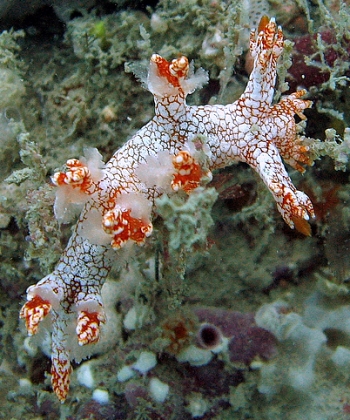
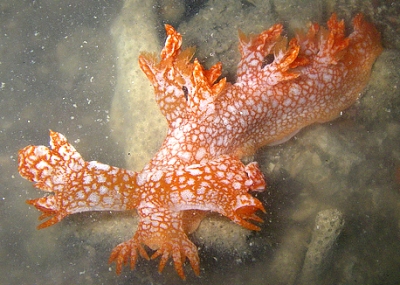
Bornella sp. 2
Order: NUDIBRANCHIA
Suborder: DENDRONOTINA
Family: Bornellidae
PHOTO
Upper: Pulau Hantu, 13m, Singapore, South China Sea, 29 April 2007, On silty rubbles/substrate. Length: 35 mm. Photographer: Toh Chay Hoon. Lower: Beting Bronok, 0m, Singapore, South China Sea, 05 July 2008, Submerged reef intertidal. Length: 100 mm. Photographer: Toh Chay Hoon.
I suspect this is another unnamed species which has escaped our notice. Perhaps it is a very extreme form of Bornella hermanni? There seem to be only three pairs of dorso-lateral processes while in B. stellifer we would expect five or six. However the dorso-lateral processes are shaped more as in B. hermanni with one major lobe or papilla, and a number of smaller ones. However the heavy white pigmentation and red reticulate pattern, even on the dorso-lateral processes are quite different. In this animal the major papilla in each lateral process, and the major papilla on the rhinophore sheaths is contoured with vertical wrinkles which seem present even when the processes are extended. The papillae also have a reddish reticulate pattern, in some cases the red extending into larger patches.
The rhinophore sheath is similar to B. hermanni in shape, but again, the red reticulate pattern is quite different. The translucent red of the rhinophores and in some animals the gills as well, is unusual, but it could just be a manifestation of a population with an excess of red pigmentation. I could call this Bornella cf. hermanni, but that might be confusing, so until we can examine specimens anatomically I have separated it as Bornella sp. 2.
Authorship detailsRudman, W.B., 2009 (February 12) Bornella sp. 2 [In] Sea Slug Forum. Australian Museum, Sydney. Available from http://www.seaslugforum.net/find/bornsp2
Related messages
Re: Bornella stellifer? from Singapore [3]
February 12, 2009
From: Toh Chay Hoon
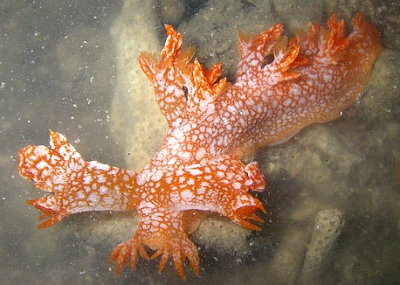
Concerning message #22199:
Dear Dr Bill,
Here's another Bornella nudibranch for the database. It has orange gills.
Locality: Beting Bronok, 0m, Singapore, South China Sea, 05 July 2008, Submerged reef intertidal. Length: 100 mm. Photographer: Toh Chay Hoon.
Thanks,
Chay Hoon
sonnenflower@gmail.com
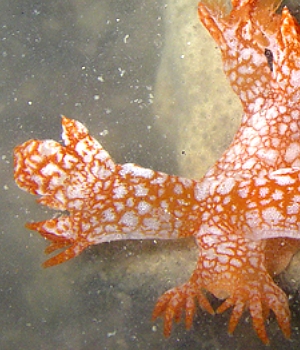

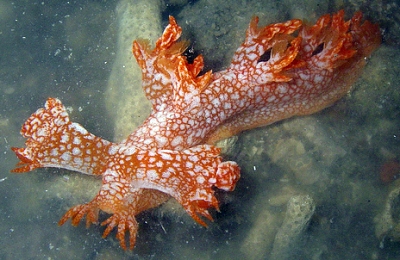
Dear Chay Hoon,
I think this is the same as the one in your other message [#22204] which I have decided to call Bornella sp. 2. In these photos you can clearly see the wrinkles on the dorso-lateral processes. The large sail-like process on the rhinophores sheath certainly reminds me of Bornella hermanni, but without some anatomical information, I think it would be a bit premature to ignore the wrinkles and body colour. It is indeed an interesting find.
Best wishes,
Bill Rudman
Re: Bornella stellifer? from Singapore [2]
February 12, 2009
From: Toh Chay Hoon
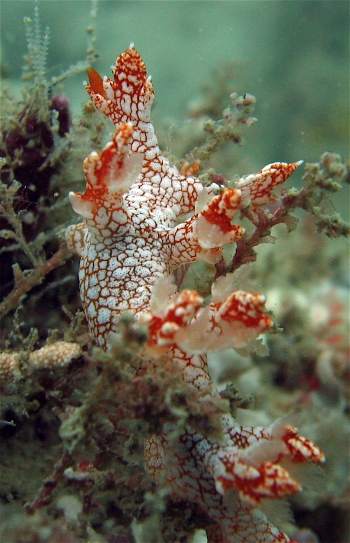
Concerning message #22199:
Dear Dr Bill,
Here are 2 more photos of the nudibranch taken from another angle. Hope this helps.
Locality: Pulau Hantu, 13 m, Singapore, South China Sea, 29 April 2007, On silty rubbles/substrate. Length: 35 mm. Photographer: Toh Chay Hoon.
Thanks.
Chay Hoon
sonnenflower@gmail.com
Toh C.H., 2009 (Feb 12) Re: Bornella stellifer? from Singapore [2]. [Message in] Sea Slug Forum. Australian Museum, Sydney. Available from http://www.seaslugforum.net/find/22250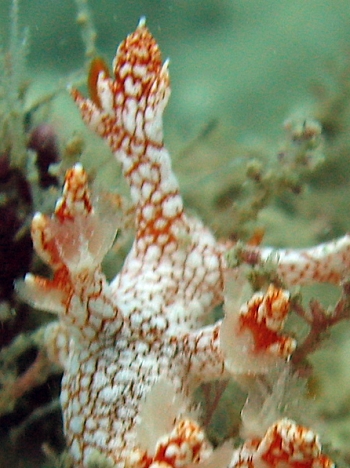
Dear Chay Hoon,
Thanks very much for the extra photos. I suspect this is an unnamed species which has escaped our notice. Perhaps it is a very extreme form of Bornella hermanni? There seem to be only three pairs of dorso-lateral processes as in that species, while in B. stellifer we would expect five or six. However the dorso-lateral processes are shaped more as in B. hermanni, with one major lobe or papilla, and a number of smaller ones. However the heavy white pigmentation and red reticulate pattern, even on the dorso-lateral processes, are quite different. In this animal the major papilla in each lateral process, and the major papilla on the rhinophore sheaths is contoured with vertical wrinkles which seem present even when the processes are extended. The papillae also have a reddish reticulate pattern, in some cases the red extending into larger patches.
The rhinophore sheath is similar to B. hermanni in shape, but again, the red reticulate pattern is quite different. The translucent red of the rhinophores and in some animals the gills as well, is unusual, but it could just be a manifestation of a population with an excess of red pigmentation. I could call this Bornella cf. hermanni, but that might be confusing, so until we can examine specimens anatomically I have separated it as Bornella sp. 2.
Best wishes,
Bill Rudman
Bornella stellifer? from Singapore
January 29, 2009
From: Toh Chay Hoon

Note added 12 February 2009: This has been moved to Bornella sp. 2. See message #22250].
Concerning message #7721:
Dear Dr Bill,
Here's a Bornella nudibranch from Singapore. Is this Bornella stellifer?
Locality: Pulau Hantu, 13m, Singapore, South China Sea, 29 April 2007, On silty rubbles/substrate. Length: 35 mm. Photographer: Toh Chay Hoon.
Thanks.
Chay Hoon
sonnenflower@gmail.com
Toh C.H., 2009 (Jan 29) Bornella stellifer? from Singapore. [Message in] Sea Slug Forum. Australian Museum, Sydney. Available from http://www.seaslugforum.net/find/22199Dear Chay Hoon,
Thanks for this interesting find. It is surely the same as the animal in Alice Lee's earlier message, which you refer to [#7721], which I considered to be a variation of Bornella stellifer. Her animal was 8 cm long so much larger than yours. In both specimens the white pigmentation is very intense but there are indications of subterminal orange rings on the papillae on the oral lobes, which with the orange on the dorso-lateral processes makes me think this is B. stellifer. Unfortunately in both hers and your photo the rhinophore sheath appendages and the dorso-lateral processes seem to be very contracted so I can get no good idea of their shape. If you have any photos showing the animal in a more 'relaxed' state it might be helpful.
A large animal - 10 cm long - photographed in Michael Aw's message [#8054] from Sarawak also seems to be a form of B. stellifer. It also has the heavy coating of white, but the orange markings are vertical lines rather than a reticulate pattern. Interestingly it looks very like the original painting of Bornella adamsii J. E. Gray in M. E. Gray, 1850, which is the type species of the genus, but is now considered a synonym of B. stellifer. It has the typical sub-apical orange rings on the dorso-lateral processes and the oral lobe papillae.
Best wishes,
Bill Rudman
Bornella stellifer From Bintan, Indonesia
August 16, 2002
From: Alice Lee
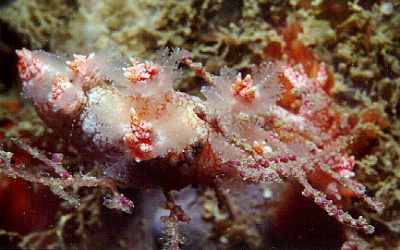
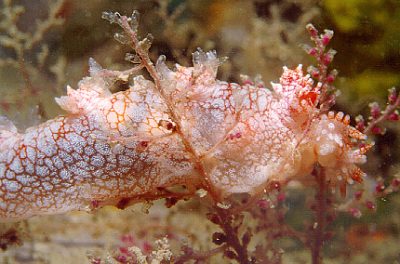
Note added 12 February 2009: This has been moved to Bornella sp. 2. See message #22250].
Dear Bill,
These nudibranchs were found on the Dutch Freighter wreck north of Bintan, Riau Archipelago, Indonesia.
Depth: 20m
Size: 8cm
3 August 2002
The head looks pretty strange - it looks like the head of a wobbegong shark.
Regards,
Alice
alee@dlink.com.sg
Lee, A., 2002 (Aug 16) Bornella stellifer From Bintan, Indonesia. [Message in] Sea Slug Forum. Australian Museum, Sydney. Available from http://www.seaslugforum.net/find/7721Dear Alice,
These photo of Bornella stellifer are good because they show it on [feeding on?] a colony of hydroids. The main feature of the very distinctive head you mention are the two oral 'lappets' flanking the mouth. Each looks like a hand with outstretched fingers. The name 'stellifer' meaning starlike or 'carrying stars' is a reference to these structures, as is another name for this species, B. digitata, which refers tp them as 'digits' or 'fingers'.
Best wishes,
Bill Rudman
